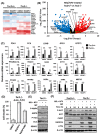Energy Stress-Mediated Cytotoxicity in Tuberous Sclerosis Complex 2-Deficient Cells with Nelfinavir and Mefloquine Treatment
- PMID: 30308940
- PMCID: PMC6210998
- DOI: 10.3390/cancers10100375
Energy Stress-Mediated Cytotoxicity in Tuberous Sclerosis Complex 2-Deficient Cells with Nelfinavir and Mefloquine Treatment
Abstract
To find new anti-cancer drug therapies, we wanted to exploit homeostatic vulnerabilities within Tuberous Sclerosis Complex 2 (TSC2)-deficient cells with mechanistic target of rapamycin complex 1 (mTORC1) hyperactivity. We show that nelfinavir and mefloquine synergize to selectively evoke a cytotoxic response in TSC2-deficient cell lines with mTORC1 hyperactivity. We optimize the concentrations of nelfinavir and mefloquine to a clinically viable range that kill cells that lack TSC2, while wild-type cells tolerate treatment. This new clinically viable drug combination causes a significant level of cell death in TSC2-deficient tumor spheroids. Furthermore, no cell recovery was apparent after drug withdrawal, revealing potent cytotoxicity. Transcriptional profiling by RNA sequencing of drug treated TSC2-deficient cells compared to wild-type cells suggested the cytotoxic mechanism of action, involving initial ER stress and an imbalance in energy homeostatic pathways. Further characterization revealed that supplementation with methyl pyruvate alleviated energy stress and reduced the cytotoxic effect, implicating energy deprivation as the trigger of cell death. This work underpins a critical vulnerability with cancer cells with aberrant signaling through the TSC2-mTORC1 pathway that lack flexibility in homeostatic pathways, which could be exploited with combined nelfinavir and mefloquine treatment.
Keywords: ER stress; TSC; cancer therapy; energy homeostasis; mTOR; mefloquine; nelfinavir.
Conflict of interest statement
The authors declare no conflict of interest. RE is non-executive director of Biostatus Ltd., the vendor of DRAQ7.The funders had no role in the design of the study; in the collection, analyses, or interpretation of data; in the writing of the manuscript, and in the decision to publish the results.
Figures





Similar articles
-
Loss of tuberous sclerosis complex 2 sensitizes tumors to nelfinavir-bortezomib therapy to intensify endoplasmic reticulum stress-induced cell death.Oncogene. 2018 Nov;37(45):5913-5925. doi: 10.1038/s41388-018-0381-2. Epub 2018 Jul 6. Oncogene. 2018. PMID: 29980790
-
Targeting protein homeostasis with nelfinavir/salinomycin dual therapy effectively induces death of mTORC1 hyperactive cells.Oncotarget. 2017 Jul 25;8(30):48711-48724. doi: 10.18632/oncotarget.16232. Oncotarget. 2017. PMID: 28415776 Free PMC article.
-
Finding a cure for tuberous sclerosis complex: From genetics through to targeted drug therapies.Adv Genet. 2019;103:91-118. doi: 10.1016/bs.adgen.2018.11.003. Epub 2018 Dec 20. Adv Genet. 2019. PMID: 30904097 Review.
-
Vps34-mediated macropinocytosis in Tuberous Sclerosis Complex 2-deficient cells supports tumorigenesis.Sci Rep. 2018 Sep 21;8(1):14161. doi: 10.1038/s41598-018-32256-x. Sci Rep. 2018. PMID: 30242175 Free PMC article.
-
Mammalian target of rapamycin and tuberous sclerosis complex.J Dermatol Sci. 2015 Aug;79(2):93-100. doi: 10.1016/j.jdermsci.2015.04.005. Epub 2015 Apr 25. J Dermatol Sci. 2015. PMID: 26051878 Review.
Cited by
-
The Anti-Cancer Properties of the HIV Protease Inhibitor Nelfinavir.Cancers (Basel). 2020 Nov 19;12(11):3437. doi: 10.3390/cancers12113437. Cancers (Basel). 2020. PMID: 33228205 Free PMC article. Review.
-
Drug Resistance and Novel Therapies in Cancers.Cancers (Basel). 2020 Oct 12;12(10):2929. doi: 10.3390/cancers12102929. Cancers (Basel). 2020. PMID: 33053621 Free PMC article. No abstract available.
-
Investigation of the mechanism of action of mefloquine and derivatives against the parasite Echinococcus multilocularis.Int J Parasitol Drugs Drug Resist. 2023 Apr;21:114-124. doi: 10.1016/j.ijpddr.2023.03.002. Epub 2023 Mar 9. Int J Parasitol Drugs Drug Resist. 2023. PMID: 36921443 Free PMC article.
References
-
- Tee A.R., Fingar D.C., Manning B.D., Kwiatkowski D.J., Cantley L.C., Blenis J. Tuberous sclerosis complex-1 and -2 gene products function together to inhibit mammalian target of rapamycin (mTOR)-mediated downstream signaling. Proc. Natl. Acad. Sci. USA. 2002;99:13571–13576. doi: 10.1073/pnas.202476899. - DOI - PMC - PubMed
Grants and funding
LinkOut - more resources
Full Text Sources
Miscellaneous

